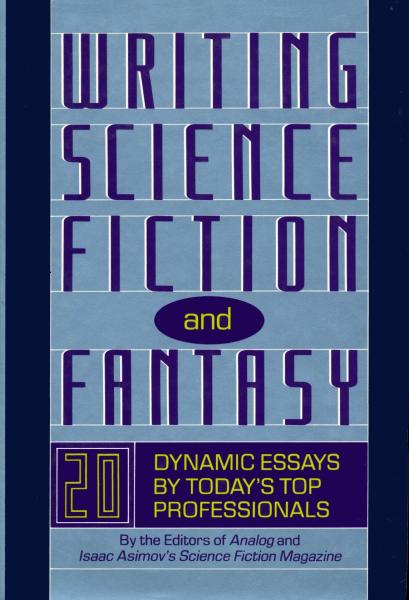
One of the books I considered for my Gardner Dozois tribute last week was this writing guide from 1991 from “The Editors of Asimov’s Science Fiction Magazine and Analog.” Of course, some of these essays are dated but Gardner Dozois’s “Living in the Future: You are What You Eat” is still relevant. My favorite essay is Connie Willis’s “Learning to Write Comedy, or, Why It’s Impossible and How to Do It.” Willis discusses plenty of comic writers and shows how they work their magic. If you’re interested in reading about what editors in the early 1990s were interested in buying, this is the book for you. GRADE: B
TABLE OF CONTENTS:
ACKNOWLEDGMENTS ix
Introduction 1
PART ONE: STORYTELLING
On the writing of speculative fiction / Robert A. Heinlein — 5
Living the future : you are what you eat / Gardner Dozois — 12
Plotting / Isaac Asimov — 28
Dialog / Isaac Asimov — 33
You and your characters / James Patrick Kelly — 38
Seeing your way to better stories / Stanley Schmidt — 50
Turtles all the way down / Jane Yolen — 62
Learning to write comedy, or, Why it’s impossible and how to do it / Connie Willis — 76
PART TWO: IDEAS AND FOUNDATIONS
Good writing is not enough / Stanley Schmidt — 91
The creation of imaginary world : the world builder’s handbook and pocket companion / Poul Anderson — 105
The creation of imaginary beings / Hal Clement –Building a starfaring age / Norman Spinrad — 129
How to build a future / John Barnes 147
Building a starfaring age / Norman Spinrad 185
The ideas that wouldn’t die / Stanley Schmidt — 200
PART THREE: THE BUSINESS OF WRITING
The mechanics of submission / Sheila Williams — 211
Revisions / Isaac Asimov — 221
Writing for young people / Isaac Asimov — 226
New writers / Isaac Asimov — 231
Authors vs. editors / Stanley Schmidt — 236
Market resources / Ian Randal Strock — 250
PART FOUR: APPENDIX
Guidelines (Analog and Asimov’s) 259
Can’t believe Asimov wrote an essay on dialogue. He wrote some of the worst dialogue you’ll ever read.
Steve, when I reread Asimov’s FOUNDATION trilogy, I was shocked at all the dialogue (very chatty books!)…and how wooden it was.
As several critics, Budrys and others, noted, Asimov usually didn’t distinguish fiction from essays in basic approach. Call it Platonic. A few stories, such as “The Ugly Little Boy”, get a bit sharper thus.
Todd, most of Asimov’s fiction was didactic. In both the FOUNDATION trilogy and the Robot novels there were frequent “info-dumps.”
I like Connie Willis, and those are the kinds of essays I enjoy. Reminds me of Sondheim’s book, where he discussed the strengths and weaknesses of other composers and lyricists.
Jeff, exactly! I love to read about what professionals in any field think of other professionals.
I am a sucker for this sort of book too. Will look for it.
Patti, despite the 1991 publishing date, many of the essays in WRITING SCIENCE FICTION AND FANTASY hold up. You would enjoy the Connie Willis essay on humor.
I just used Connie Willis’ To Say Nothing of the Dog for the bookstore book group. This is one of my favorite books. I think Willis does time travel VERY well indeed.
Only two (2) people showed up and they didn’t like the book – too much “emphasis” on Victorian novels!
Maybe I’ll try this one with the Cloak& Clue group. When I mentioned it at the May meeting, it received very enthusiastic support.
Beth, I’ve enjoyed Connie Willis’s SF novels and stories for decades. You’re right: Connie Willis does time travel really really well!
I’m working my way through the Gardner Dozois edited ROGUES, a 909 page anthology spanning many genres. I read a story or two between longer stuff.
Rick, I enjoyed ROGUES especially “How the Marquis Got His Coat Back” by Neil Gaiman, “The Inn of the Seven Blessings” by Matt Hughes, and “Tawny Petticoats” by Michael Swanwick.
I liked that Hughes story too. I’m just past the Swanwick.
Rick, when I read ROGUES I had previously finished Neil Gaiman’s NEVERWHERE so “How the Marquis Got His Coat Back” really resonated with me.
Definite Next Reads in this mode: CREATING SHORT FICTION by Damon Knight; STORYTELLER by Kate Wilhelm; THE CRAFT OF SCIENCE FICTION edited by Reginald Bretnor.
The only other Best of the Year editor to have a similarly long run at one annual to Dozois, I’ve realized, is Martha Foley at BEST AMERICAN SHORT STORIES for 36 years…she died while still editing it, as well…and also was editor of a similarly key magazine, STORY.
Todd, I’ve read many of Martha Foley’s BEST AMERICAN SHORT STORY anthologies over the years. I have read Reginald Bretnor’s THE CRAFT OF SCIENCE FICTION and Damon Knight’s CREATING SHORT STORIES, but I somehow missed Kate Wilhelm’s STORYTELLER. I’ll have to track down a copy.